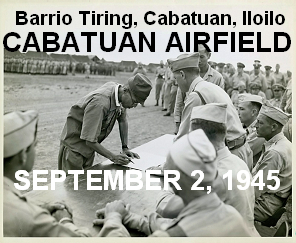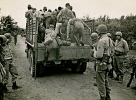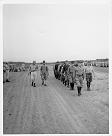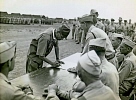






Col. Ryoichi Tozuka signs the surrender instrument
as Col. Raymond G. Stanton looks on.
Cabatuan Airfield
Barrio Tiring, Cabatuan, Iloilo
Panay Island, Philippines, September 2, 1945
|
|
- o -
|

Kumamoto City memorial marker, 20 March 1977. Page 141.
|
|
11.4 Seven Executions by Hanging
Following my trial was that of WO Fusataro Shin for the murder of several civilians. The lawyer was also Simon. But by this time, WO Shin was completely obsessed by the supernatural. Astonishing Simon, his affidavit stated: ‘I know perfectly what you, the US Forces, are going to do with me. I have a god abiding in me, and through his words, I know everything.’ Matsuzaki and I warned him that this would not suffice for an appropriate affidavit for a trial. WO subsequently rewrote this, but his fanatic words and behavior might have spoiled the impression he made for lawyer Simon. His having been a former member of the Kempeitai was disadvantageous for the trial. The proceedings of his trial were carried out in complete silence. He had no chance to speak out; and though the lawyer had assured him, ‘No problem, it’s going to be all right,’ Shin received the ‘death by hanging’ sentence around July 15.
The trial of 1st Lieutenant Hajime Fujii was based on dozens of killings. The prosecutor made a Filipino interpreter and spy who had served Fujii, Francisco Manzanilla (called Jiro among the Japanese Army soldiers), stand as a powerful witness. When Francisco met Fujii at the court, he briefly looked apologetic but soon replied to the questions of the prosecutor. Fujii did not object to his testimonies; if he countered the statements of Francisco, things might go against Francisco in his own trial as a Japanese collaborator. Furthermore, countering Francisco’s testimony might increase the number of war criminal suspects among the soldiers of Fujii’s company. So he kept silent. A female witness appeared at the Court. While testifying that Fujii had humiliated her, she collapsed crying. Fujii had already made up his mind that there was no way to avoid the death penalty and his attitude showed his belief there was nothing he could do by making a fuss. His defense lawyer Springer was moved by his transcendental attitude, and he painstakingly took the argument as follows: ‘Although Fujii caused many incidents, the fact that he was promoted without receiving any punishment showed that his deeds were all according to the orders given by his commanders.’
Although Fujii himself did not call in any witnesses, Lieutenant General Kôno Colonel Tozuka had been summoned as his defense witnesses. The defense lawyer tried to have them testify that they were the ones who gave Fujii his orders. However, both Kôno and Tozuka consistently replied that they knew nothing and made no remarks to protect Fujii. As expected, his sentence was ‘death by hanging.’
The trial of 1st Lieutenant Chiyomi Toyota started towards the end of July 1946. The grounds for his prosecution were incidents in Sara. As garrison commander at Sara and a representative of all Japanese Army officers who joined the punitive expedition there, a guilty sentence was expected for him. The prosecution framed Lieutenant Toyota as a war criminal suspect though factual details of the relevant incidents did not fit . Captain Watanabe, in fact, committed the crimes. Therefore, the personnel dispatched to investigate the crime scenes could not find anything that proved his alleged crimes.
The prosecution was surprised but could not withdraw the indictment. The lawyer asked Toyota to admit the indictments as facts and that they would get him a sentence of less than twenty-five years. Toyota chose not to conform, relying on the facts. The trial started. I stood as witness and testified as to the absence of Toyota at the supposed crime scenes since he had been dispatched to completely different areas. In the end, Lieutenant Toyota received a 25-year hard labor sentence as the lawyer had predicted.
There was a joint court trial for Sergeant Tokizo Makita and Corporal Hisaki Itai, accused of the murder of civilians during the period of their service at the garrison in Leon, Iloilo. Sergeant Makita had tried to escape twice. From the start, he was not given any consideration and was treated as a prisoner with a death penalty. Corporal Itai, who always behaved like a gangster, quarreled with his lawyer and made a bad impression on him. Neither of them received proper advice and were given the death penalty just as easily as it is to twist a baby’s wrist.
The trial of Sergeant Matsuzaki came next. The prosecutor was Shepherd who was in charge of investigating the Panay cases at the War Criminal Suspects’ camp at Nichols Airfield. While he was using Matsuzaki as interpreter, he had been impressed with Matsuzaki’s personality. At the time of the trial, Shepherd realized that the prosecution’s case drawn up by the guerrilla side was absolutely false. Banda, Matsuzaki’s lawyer instructed him, ‘I’m sure your penalty is going to be a five-year imprisonment, so admit the facts for which you are indicted.’ As instructed, Matsuzaki admitted guilt from the start. The prosecutor presented witnesses to the court as formally required, including a former spy Jesus Astrologo and a few others. But the witnesses tried to protect Matsuzaki as if they were witnesses for the accused, saying, ‘Matsuzaki was a gentleman and was kind to anyone.’ The trial ended in less than two hours and Matsuzaki got five years as his lawyer had predicted. It was an abnormally short trial at the Manila War Crimes Tribunal.
The next case involved the unit headquarters represented by Captain Jiro Motoki. Jose Dimzon, a former spy for the headquarters was presented as a prosecution witness, along with several of his relatives, but Motoki was handed a sentence of life imprisonment. Sergeant Hamamoto of the Machine-gun unit, who represented those prosecuted for crimes on Guimaras Island was also given a life sentence due to the excellent defense of his lawyer, Banda.
The trial of the Panay cases ended on August 19 with the trial of Sergeant Hamamoto. The sentences were as follows: seven were sentenced to death by hanging–the garrison commander Lieutenant General Kôno, the unit commander Lieutenant Colonel Tozuka, lst Lieutenant Hajime Fujii, Second Lieutenant Noriyuki Otsuka, Kempeitai WO Fusataro Shin, Sergeant Tokizo Makita, and Lance Corporal Hisaki Itai. Those who got life imprisonment were Captain Jiro Motoki, Master Sergeant Kuwano, and Sergeant Hamamoto. First Lieutenant Toyota and I got a 25-year sentence while Sergeant Matsuzaki got a 5-year imprisonment.
The results seemed to show that the standard rule at that time was also applied to the Panay Cases. There was a balance in the sentences for life and death. We were imprisoned in the Canlubang camp for war criminals near Laguna Lake in Laguna Province. Prisoners with the death penalty were placed under strict guard in solitary cells. Prisoners with life and other set terms of imprisonment were put in communal cells and were forced to do weeding under the scorching heat of the sun every day. I was the Mess Officer in this camp and did my best service for the prisoners with death penalty with the available fresh vegetables. As the days went by, they looked more and more pale. Every month we observed many of them from our communal cell as they were taken away to the execution grounds.
On January 15, 1947, we learned that prisoners who received prison sentences for life or for some definite time were to be sent back to Japan. On the day of departure, I went to pay a last visit to those colleagues who got the death sentence. General Kôno sat heavily on the bed and said, ‘I wish you good health.’ Fujii said, ‘When you return, give my best to my dear wife,’ and his loud laugh rang out as usual. Shin glared up at me, ‘Are you going home?’ Makita greeted me saying, ‘It’s been nice knowing you. I wish you good health.’ Itai grudgingly said, ‘I hope you will certainly avenge this.’ Colonel Tozuka and Otsuka just peeped through the slits of their cells, and the Colonel shouted, ‘Be quick and get yourself a nice wife.’ Otsuka, in the next cell, laughingly added, ‘Do not make such haste, do not.’
Thus, I parted from my comrades with whom I shared life and death, pain and joy. Later on in mid-July, when I was already imprisoned at Sugamo, the second group of prisoners from the Philippines arrived. Among them were my Go game rival, Kawachi, accused for atrocities in Bataan Peninsula. As an interpreter, he was present at the executions of Colonel Tozuka and other Panay prisoners. As soon as we met, he told me how the executions were carried out.
Every Friday, diggers from among prisoners of the suspects’ camp were brought together to dig holes at the corner where graves with white crosses stood in a row. By the number of holes they dug, they knew how many were going to be executed. Towards the evening, an ambulance marked with a white cross and a jeep escort entered the camp. Camp Commander Berg then called out the names of prisoners with the death penalty one by one. They grudgingly made their way into the ambulance. The execution ground was 700 meters away from the camp barracks and was covered by galvanized iron sheets. Next to it was a cell made of wire mesh where prisoners were kept waiting.
As the executioner told the prisoner that he was going to conduct the execution, a military chaplain with a bible in his hands said a prayer and asked the prisoner if he wanted anything. After this, a door on the execution ground was opened revealing 13 steps to the gallows. Two armed guards held both sides of the prisoner, and with the signal, ‘Let’s go!’ quickly ran up the stairs. Soon, the trap door slammed. When a doctor confirmed the death, the body was carried out from under the scaffold into an ambulance.
Of the Panay prisoners, the first executions were on February 24, 1947. These were the Kempeitai WO Fusataro Shin, Sergeant Tokizo Makita and Lance Corporal Hisaki Itai. While they were listening to the chaplain’s message of ‘You are going to Heaven,’ Lance Corporal Itai became furious and turned on the Chaplain, demanding, ‘How could you talk about Heaven when you are going to hang us?’ A month later, on March 31, the executions of the Colonel Tozuka and 2nd Lieutenant Otsuka were carried out. Second Lieutenant Otsuka left a poem, ‘Speaking of flowers, it’s the cherry blossom that is most beautiful as it scatters; I’d like to show you how a man should die.’
Another month later, on April 24, Lieutenant General Kôno, 1st Lieutenant Fujii, and Major Mikami of the Army Hyô Group of Mindanao were executed. Lieutenant General Kôno left a haiku poem, ‘The spring breeze has scattered dew drops at the end of a leaf.’ First Lieutenant Fujii climbed up the stairs, joking to his old mahjong-mate Mikami, ‘I wish we could play mahjong one more time.’
In June 1950, when the Korean War broke out, the sentences handed down to prisoners were reduced one after another. On February 10, 1954, I also got out of Sugamo Prison. The three years during the war, and eight years and four months, which I spent as a war criminal suspect and then a war criminal, had thoroughly exhausted me. Fourteen years after my enlistment into the Fukuoka Regiment in February 10, 1940, I was at last set free from the restrictions of war and imprisonment as a war criminal.
|
|